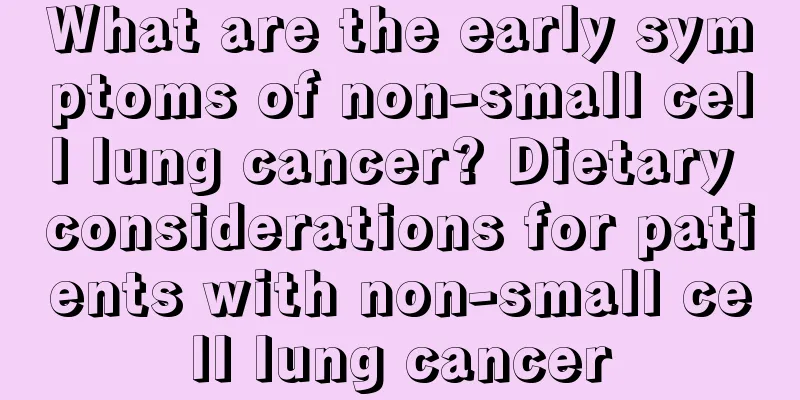What are the early symptoms of non-small cell lung cancer? Dietary considerations for patients with non-small cell lung cancer

|
Lung cancer is one of the most common malignant tumors in the world and has become the leading cause of death from malignant tumors in urban populations in my country. Non-small cell lung cancer includes squamous cell carcinoma (SCC), adenocarcinoma, and large cell carcinoma. Compared with small cell carcinoma, its cancer cells grow and divide more slowly, and spread and metastasize relatively late. Non-small cell lung cancer accounts for about 80% of all lung cancers. About 75% of patients are already in the middle and late stages when they are discovered, and the 5-year survival rate is very low. 1. Early symptoms (1) Chest pain The early chest pain symptoms of lung cancer are mild, mainly manifested as dull pain, dull pain, and the location is not certain, and the relationship with breathing is also uncertain. If the pain persists, it means that the cancer may involve the pleura. (2) Sputum and blood When tumor inflammation causes necrosis and capillary damage, there will be a small amount of bleeding, which is often mixed with sputum and appears intermittently or intermittently. Many lung cancer patients seek medical treatment due to sputum and blood. (3) Low-grade fever When the tumor blocks the bronchus, there is often an obstructive lung lobe, with varying degrees. The mild case has only a low fever, and the severe case has a high fever. It can be temporarily improved after taking medicine, but it will relapse soon. (4) Cough Because lung cancer grows on the bronchial lung tissue, it usually causes respiratory irritation symptoms and irritating cough. 2. Late symptoms Patients with advanced non-small cell lung cancer have symptoms such as fatigue, weight loss, and decreased appetite, as well as local symptoms such as dyspnea, cough, and hemoptysis. 1. Smoking Smoking is currently considered to be the most important high-risk factor for lung cancer. There are more than 3,000 chemical substances in tobacco, among which polycyclic aromatic hydrocarbons (such as benzopyrene) and nitrosamines have strong carcinogenic activity. Polycyclic aromatic hydrocarbons and nitrosamines can cause DNA damage in bronchial epithelial cells through various mechanisms, activating oncogenes (such as Ras genes) and inactivating tumor suppressor genes (such as p53, FHIT genes, etc.), thereby causing cell transformation and eventually cancer. 2. Occupational and environmental exposure Lung cancer is the most important type of occupational cancer. It is estimated that about 10% of lung cancer patients have a history of environmental and occupational exposure. It has been proven that the following 9 occupational environmental carcinogens increase the incidence of lung cancer: byproducts of aluminum products, arsenic, asbestos, bis-chloromethylether, chromium compounds, coke ovens, mustard gas, nickel-containing impurities, and vinyl chloride. Long-term exposure to substances such as beryllium, cadmium, silicon, and formalin will also increase the incidence of lung cancer. Air pollution, especially industrial waste gas, can cause lung cancer. 3. Ionizing radiation The lung is an organ that is more sensitive to radiation. The number of people suffering from lung cancer among survivors of the atomic bomb explosion in Japan has increased significantly. 4. In patients with chronic lung infections such as tuberculosis and bronchiectasis, the bronchial epithelium may metaplasia into squamous epithelium during the chronic infection, leading to cancer, but this is relatively rare. 5. Genetic factors Family clustering, genetic susceptibility, reduced immune function, metabolic and endocrine dysfunction may also play an important role in the occurrence of lung cancer. Many studies have shown that genetic factors may play an important role in people and/or individuals who are susceptible to environmental carcinogens. 6. Air pollution The high incidence of lung cancer in developed countries is mainly due to the pollution of the atmosphere by harmful substances such as benzopyrene carcinogenic hydrocarbons produced by the combustion of oil, coal and internal combustion engines and asphalt road dust in industrial and transportation-developed areas. Air pollution and smoking may promote each other and play a synergistic role in the incidence of lung cancer. Daily prevention of lung cancer 1. Quit smoking. Smoking is one of the most important factors leading to lung cancer. Both active and passive smoking can cause great harm to the body. Therefore, quitting smoking is the first choice for preventing lung cancer. 2. Develop correct eating habits. To prevent lung cancer, you must eat regularly, eat more fungi and bean products, and drink less alcohol. 3. Adhere to physical examinations. Every physical examination should be done with chest X-rays in the front and lateral positions. Try to do chest X-rays every year. For suspected cases, conduct detailed examinations. Adhere to physical examinations to achieve early detection and early treatment. Health education 1. Prohibition and control of smoking To prohibit and control smoking, we must first focus on reducing the proportion of smokers in the population. We need to formulate certain laws or regulations to restrict people, especially teenagers from smoking. 2. Control air pollution. Do a good job in environmental protection and effectively control air pollution, so as to achieve the purpose of preventing lung cancer. 3. Occupational protection For mining areas where radioactive ores are mined, effective protective measures should be taken to minimize the amount of radiation received by workers. For workers exposed to carcinogenic compounds, various effective labor protection measures must be taken to avoid or reduce contact with carcinogenic factors. 4. Prevention and treatment of chronic bronchitis Since the incidence of lung cancer in patients with chronic bronchitis is higher than that in those without chronic bronchitis, active prevention and treatment of chronic bronchitis is of certain significance in preventing lung cancer, especially to persuade smokers with chronic bronchitis to quit smoking, because the incidence of lung cancer in people with chronic bronchitis who smoke is higher. 5. Early detection, early diagnosis and early treatment. The screening methods for early lung cancer are still unsatisfactory. The cost of screening for lung cancer in the population is very expensive, and the possibility of reducing the mortality rate of lung cancer is very small. Studies have used chemical prevention such as the use of cyclooxygenase (COX) inhibitors and lipoxygenase inhibitors to try to block the development of carcinogenic factors. Some foods rich in vitamin E, carotenoids, retinal, selenium, etc. also have a preventive effect on lung cancer. (I) Chemotherapy Chemotherapy is the main treatment for lung cancer, and more than 90% of lung cancers require chemotherapy. The efficacy of chemotherapy for small cell lung cancer is relatively certain regardless of early or late stages, and even about 1% of early small cell lung cancers are cured by chemotherapy. Chemotherapy is also the main means of treating non-small cell lung cancer, and the tumor remission rate of chemotherapy for non-small cell lung cancer is 40% to 50%. Chemotherapy generally cannot cure non-small cell lung cancer, but can only prolong the patient's survival and improve the quality of life. Chemotherapy is divided into therapeutic chemotherapy and adjuvant chemotherapy. Chemotherapy requires the use of different chemotherapy drugs and different chemotherapy regimens according to the different histological types of lung cancer. In addition to killing tumor cells, chemotherapy also damages normal cells in the human body, so chemotherapy needs to be carried out under the guidance of an oncologist. In recent years, the role of chemotherapy in lung cancer is no longer limited to patients with advanced lung cancer who cannot undergo surgery, but is often included in the comprehensive treatment plan for lung cancer as a systemic treatment. Chemotherapy inhibits the bone marrow hematopoietic system, mainly the decrease of white blood cells and platelets, and can be treated with granulocyte colony stimulating factor and platelet stimulating factor. Chemotherapy is divided into therapeutic chemotherapy and adjuvant chemotherapy. (II) Radiotherapy 1. Treatment principles Radiotherapy has the best effect on small cell lung cancer, followed by squamous cell carcinoma, and the worst on adenocarcinoma. The irradiation field of lung cancer radiotherapy should include the primary lesion and the mediastinum of lymph node metastasis. At the same time, it should be supplemented with drug therapy. Squamous cell carcinoma has moderate sensitivity to radiation, and the lesions are mainly local invasion, and the metastasis is relatively slow, so radical treatment is often used. Adenocarcinoma has poor sensitivity to radiation and is prone to blood metastasis, so simple radiotherapy is rarely used. Radiotherapy is a local treatment and often requires combined chemotherapy. The combination of radiotherapy and chemotherapy can be combined with synchronous chemoradiotherapy or alternating chemoradiotherapy depending on the patient's condition. 2. Classification of radiotherapy According to the purpose of treatment, it is divided into radical treatment, palliative treatment, preoperative neoadjuvant radiotherapy, postoperative adjuvant radiotherapy and intracavitary radiotherapy. 3. Complications of radiotherapy Complications of lung cancer radiotherapy include: radiation pneumonitis, radiation esophagitis, radiation pulmonary fibrosis and radiation myelitis. The above radiotherapy-related complications are positively correlated with the radiotherapy dose, and there are also individual differences. (III) Surgical treatment of lung cancer Surgical treatment is the first and most important treatment method for lung cancer, and it is also the only treatment method that can cure lung cancer. The purpose of surgical treatment of lung cancer is to completely remove the primary lesion of lung cancer and metastatic lymph nodes to achieve clinical cure; to remove most of the tumor to create favorable conditions for other treatments, that is, tumor reduction surgery. Reduction surgery: It is suitable for a small number of patients, such as refractory pleural and pericardial effusions. By removing pleural and pericardial implant nodules and removing part of the pericardium and pleura, the clinical symptoms caused by pericardial and pleural effusions can be cured or relieved, and life can be prolonged or the quality of life can be improved. Reduction surgery requires local and systemic chemotherapy at the same time. Surgical treatment often requires adjuvant chemotherapy and radiotherapy before or after surgery to improve the cure rate of surgery and the survival rate of patients. The five-year survival rate of surgical treatment of lung cancer is 30% to 44%; the mortality rate of surgical treatment is 1% to 2%. 1. Indications for surgery Surgical treatment of lung cancer is mainly suitable for early and middle stage (I to II) lung cancer, stage IIIa lung cancer, and some selective stage IIIb lung cancer with tumors confined to one side of the chest cavity. (1) Stage I and II lung cancer; (2) Stage IIIa non-small cell lung cancer; (3) Partial stage IIIb non-small cell lung cancer with lesions limited to one side of the chest cavity that can be completely removed; (4) Stage IIIa and partial stage IIIb lung cancer patients who have been downstaged after preoperative neoadjuvant chemotherapy; (5) Non-small cell lung cancer with isolated metastasis (i.e., intracranial, adrenal gland, or liver), if both the primary tumor and metastasis are suitable for surgical treatment, there are no contraindications to surgery, and the primary tumor and metastasis can be completely removed; (6) Patients with a clear diagnosis of stage IIIb non-small cell lung cancer, the tumor invades the pericardium, large blood vessels, diaphragm, and tracheal carina, and various examinations have ruled out distant and/or micrometastasis, the lesions are limited, the patient has no physiological contraindications to surgery, and the tumor-invaded tissues and organs can be completely removed. 2. Contraindications to surgery (1) Stage IV lung cancer with extensive metastasis; (2) Patients with multiple groups of fused mediastinal lymph node metastasis, especially invasive mediastinal lymph node metastasis; (3) Stage IIIb lung cancer with contralateral hilar or mediastinal lymph node metastasis; (4) Patients with severe visceral dysfunction who cannot tolerate surgery; (5) Patients with hemorrhagic diseases that cannot be corrected. 3. Selection of surgical procedures for lung cancer The principle of surgical resection is to completely remove the primary lesion and the lymph nodes in the chest cavity that may metastasize, and to preserve normal lung tissue as much as possible. Pneumonectomy should be performed with caution. (1) Wedge and local resection of the lung refers to the resection of the wedge-shaped cancer mass and the resection of part of the lung segment. It is mainly suitable for early lung cancer with a small size, the elderly and weak, poor lung function, or well-differentiated cancer with low malignancy. (2) Segmentectomy is the resection of the anatomical lung segment. It is mainly suitable for the elderly and patients with poor cardiopulmonary function with peripheral solitary early lung cancer, or partial central lung cancer with localized lesions located at the root of the lung cancer. (3) Lobectomy is suitable for peripheral and partially central lung cancers where the lung cancer is confined to one lobe. For central lung cancers, it is necessary to ensure that there is no residual cancer in the bronchial stump. If the lung cancer involves two lobes or the intermediate bronchus, a bilobectomy of the upper and middle lobes or the lower and middle lobes can be performed; (4) Bronchial sleeve lobectomy is mainly suitable for central lung cancers where the lung cancer is located at the opening of the lobar bronchus or the intermediate bronchus. The advantage of this procedure is that it can achieve complete resection of the lung cancer while preserving healthy lung tissue; (5) Bronchopulmonary artery sleeve lobectomy is mainly suitable for central lung cancers where the lung cancer is located at the opening of the lobar bronchus or the intermediate bronchus and where the lung cancer simultaneously invades the pulmonary artery trunk. In addition to bronchial resection and reconstruction, the surgery also requires resection and reconstruction of the pulmonary artery trunk. The advantage of this procedure is that it can achieve complete resection of the lung cancer while preserving healthy lung tissue. (6) Tracheal carina resection and reconstruction When the tumor exceeds the main bronchus and involves the carina or the lateral wall of the trachea but does not exceed 2 cm, tracheal carina resection and reconstruction or sleeve pneumonectomy can be performed. If one lobe of the lung is still retained, the tracheal carina resection and reconstruction of the lobe should be retained. (7) Pneumonectomy refers to a whole lung on one side, that is, a right or left pneumonectomy. It is mainly suitable for lung cancer with good cardiopulmonary function, more extensive lesions, and younger age, which is not suitable for lobectomy or sleeve lobectomy. The complication rate and mortality rate of pneumonectomy are both high, and the long-term survival rate and quality of life of patients are not as good as those of lobectomy. Therefore, the indications for surgery must be strictly controlled. 4. Surgical treatment of recurrent lung cancer Recurrent lung cancer includes the recurrence of local residual cancer after surgery and the occurrence of a second primary lung cancer in the lung. For the recurrence of residual cancer in the bronchial stump, reoperation should be attempted to perform bronchial sleeve molding to remove the residual cancer. For a second primary lung cancer that develops after complete resection of lung cancer, as long as the lung cancer is suitable for surgical treatment, the patient's visceral function can tolerate reoperation, and there are no surgical technical problems, open-chest surgery should be considered to remove the recurrent lung cancer. 1. Eat more foods that enhance immunity and prevent lung cancer, such as coix seed, sweet almonds, water chestnuts, oysters, jellyfish, yellow croaker, sea turtle, crab, horseshoe crab, clam, sea cucumber, tuckahoe, yam, jujube, black snake, green beans, mushrooms, walnuts, and turtle. 2. For cough and phlegm, eat ginkgo, radish, mustard, almonds, orange peel, loquat, olives, tangerine cake, jellyfish, water chestnut, kelp, seaweed, winter melon, loofah, sesame, figs, pine nuts, walnuts, mussels, monk fruit, peach, orange, grapefruit, etc. 3. For fever, you should eat cucumber, wax gourd, bitter gourd, lettuce, eggplant, hair algae, lily, amaranth, shepherd's purse, water spinach, agar, purslane, plum, watermelon, pineapple, pear, persimmon, orange, lemon, olive, mulberry, water chestnut, duck, and black carp. 4. For hemoptysis, you should eat green plum, lotus root, sugar cane, pear, cotton, jellyfish, sea cucumber, lotus seed, water chestnut, kelp, mustard, black bean, tofu, shepherd's purse, eggplant, milk, crucian carp, turtle, grass carp, squid, yellow croaker, turtle, oyster, and mussel. 5. Foods that can reduce the side effects of radiotherapy and chemotherapy: goose blood, mushrooms, sharks, longans, eels, walnuts, soft-shelled turtles, turtles, kiwis, water shield, day lilies, jujubes, sunflower seeds, apples, carp, mung beans, soybeans, red beans, shrimps, crabs, silver beans, loaches, catfish, grass carp, salmon, green tea, and snails. 6. Eat fruits, vegetables, and coarse grains every day. Dietary health care for lung cancer (the following information is for reference only, please consult a doctor for details) 1. Honey lung moistening and cough-relieving pills: equal parts of beehives and silkworms, and appropriate amount of honey. Grind the three herbs into powder and make pills with refined honey. Take twice a day, 6 grams each time. 2. Licorice and snow pear stewed with pig lungs: 10 grams of licorice, 2 snow pears, and about 250 grams of pig lungs. Peel the pears and cut them into pieces, wash the pig lungs and cut them into slices, squeeze out the foam, and put them in a casserole with licorice. Add a little rock sugar, an appropriate amount of water, simmer on low heat for 3 hours and take it. Once a day. 3. Rock sugar almond paste: 15 grams of sweet almonds, 3 grams of bitter almonds, 50 grams of polished rice, and an appropriate amount of rock sugar. Soak the sweet almonds and bitter almonds in water to soften and peel them, mash them, add polished rice, water and rock sugar to cook into thick porridge, once every other day. 4. Ginkgo jujube porridge: 25 grams of ginkgo, 20 red dates, and 50 grams of glutinous rice. Cook ginkgo, red dates, and glutinous rice together. Take it warm on an empty stomach in the morning and evening, which has the effects of detoxification and swelling. 5. Angelica dahurica stewed bird's nest: 9 grams of angelica dahurica, 9 grams of bird's nest, and an appropriate amount of rock sugar. Stew angelica dahurica and bird's nest in water until they are extremely rotten, filter out the residue. Add an appropriate amount of rock sugar to season and stew for a while, 1 to 2 times a day. It has the effects of nourishing the lungs and yin, relieving cough and stopping bleeding. 6. Steamed duck with ginkgo: 200 grams of ginkgo, 1 white duck. Remove the shell of ginkgo nuts, boil them in boiling water, peel and pistil them, blanch them in boiling water, and mix them with the boneless duck meat. Add clear soup and steam them in a steamer for 2 hours until the duck meat is cooked and eaten. It can be eaten frequently, and it has the effects of tonifying deficiency and relieving asthma, promoting diuresis and reducing swelling. It is suitable for patients with advanced lung cancer who have weak breath, general weakness, and excessive phlegm. 7. Schisandra stewed meat: 50 grams of Schisandra, duck or lean pork in appropriate amount. Steam or stew Schisandra with meat, and add seasoning as appropriate. Take meat, medicine, and soup together, tonify the lungs and kidneys, relieve cough and relieve asthma, and it is suitable for patients with kidney deficiency type of lung cancer. 8. Lotus seed chicken: 15 grams of lotus seeds, chicken or duck, pork in appropriate amount. Stew lotus seeds with meat and add appropriate seasoning. Take it frequently to tonify the lungs, replenish qi, and promote fluid production. It is suitable for patients with insufficient qi and blood in lung cancer. 9. Winter melon peel and broad bean soup: 60 grams of winter melon peel, 60 grams of winter melon seeds, and 60 grams of broad beans. Put the above food into the pot, add 3 bowls of water and fry until 1 bowl, then add appropriate seasoning, remove the residue and drink. It has the effects of dehumidification, diuresis and swelling. It is suitable for people with lung cancer and pleural effusion. 10. Sweet almonds, 100 ml of milk, 5 jujubes, 50 grams of polished rice, 10 grams of mulberry bark, and 3 grams of ginger. Soak the almonds in water, peel the tips, add milk to squeeze out the juice, remove the core of the jujube, slice the ginger, and set aside. First boil mulberry bark, ginger and jujube, decoct the soup, add rice to cook porridge, add almond juice when it is almost cooked, and continue to cook until the porridge is done, twice a day. This recipe can relieve cough and asthma, nourish the stomach, and prevent cancer and fight cancer. This medicinal diet can be used as a supplementary food for patients with respiratory cancer, emphysema, and cor pulmonale. Avoid food 1. Quit smoking, which is the most effective way to prevent lung cancer. 2. Drink less strong alcohol. 3. Do not eat moldy and spoiled food, and eat less pickled food. 4. When eating, chew slowly and do not eat over-scalding food. 5. Avoid spicy and irritating food: onion, garlic, leek, ginger, pepper, chili, cinnamon, etc. 6. Avoid hot food such as frying and grilling. 7. Avoid greasy, sticky and phlegm-producing food. |
<<: How to effectively prevent liver cancer and reveal the early symptoms of liver cancer in men
Recommend
4 main reasons for gastric cancer recurrence after surgery
The recurrence of gastric cancer after surgery se...
What's wrong with dizziness, weakness and nausea
In life, many people feel weak from time to time,...
Can the stomach expand?
Many people's gastrointestinal function is no...
Can aloe vera capsules cure constipation?
Everyone has a different physical constitution. S...
How to check for rectal cancer
Due to the influence of various unhealthy eating ...
Why can't you run in new shoes
We all have a similar experience, that is, the ne...
What is the first aid method for natural gas poisoning
Natural gas poisoning is a relatively common and ...
How to make rose hydrosol
I don't know if you have ever drunk rose wate...
Side effects of liposuction for weight loss
Nowadays, many women are not satisfied with their...
Can trichomoniasis be completely cured?
Trichomonas vaginitis is a common disease in norm...
What should hormone testing check?
Hormones are also called hormones. There are many...
The stomachache is relieved by farting
In life, many people do not pay attention to thei...
How to treat acne on the right cheek
Acne on the face is very annoying, but from the p...
What are the prevention methods for cardiovascular and cerebrovascular diseases
Cardiovascular and cerebrovascular diseases are a...
Do girls have kidneys?
Girls also have kidneys. Kidneys are important or...









